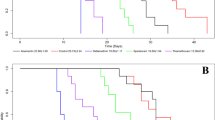Abstract
Due to the wide use of insecticides and their contribution to environmental pollution, the determination of their sublethal effects on the reproduction of parasitoids regulating pest populations is a necessity. In this work, sublethal effects of a lethal dose 20% of chlorpyrifos on the reproduction and the sex ratio of Trichogramma brassicae were assessed. The organophosphorus insecticide chlorpyrifos is one of the most used insecticides for agricultural and domestic purposes in a worldwide market. A decrease in the number of parasitized hosts was observed for females surviving the insecticide. Furthermore, while untreated females presented a very biased sex ratio in favor of daughters, the offspring of treated females surviving the insecticide presented an almost balanced sex ratio due to a decrease in the number of daughters. This decrease in sex ratio was interpreted to be resulting from a decrease in fertilized eggs due to the perturbation of nerve transmissions induced by the insecticide. These results highlight the need for considering not only the direct mortality induced by insecticides but also sublethal effects liable to modify important fitness traits involved in the dynamic of beneficial insect populations.
Similar content being viewed by others
Author information
Authors and Affiliations
Rights and permissions
About this article
Cite this article
Delpuech, ., Meyet, . Reduction in the Sex Ratio of the Progeny of a Parasitoid Wasp (Trichogramma brassicae) Surviving the Insecticide Chlorpyrifos. Arch Environ Contam Toxicol 45, 203–208 (2003). https://doi.org/10.1007/s00244-002-0146-2
Issue Date:
DOI: https://doi.org/10.1007/s00244-002-0146-2




